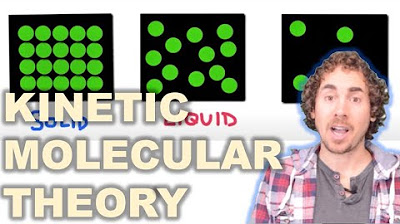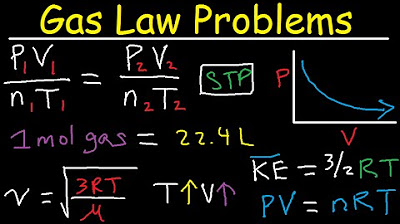9.1 Pressure and Kinetic Molecular Theory of Gases | High School Chemistry
TLDRThis video lesson introduces the kinetic molecular theory as part of a high school chemistry series on gases. It contrasts the properties of gases, liquids, and solids, explaining gases have no definite shape or volume, making them compressible. The lesson covers the definition of pressure, its mathematical expression, and common units. It delves into the kinetic molecular theory, highlighting key principles like random motion, negligible molecular volume, no attractive forces, elastic collisions, and the relationship between kinetic energy and temperature. The lesson emphasizes ideal gas behavior at low pressures and high temperatures, providing a foundation for understanding gas laws.
Takeaways
- 🌟 The first lesson in the chapter on gases focuses on the kinetic molecular theory, which is also known as the ideal gas theory, and will be contrasted with the behavior of solids and liquids.
- 🔍 Gases have no definite shape or volume and will expand or contract to fill any container, unlike liquids and solids which have definite volumes and shapes.
- 🌌 A gas is made up of mostly empty space with molecules or atoms spread out, which makes gases compressible and different from the more compact structures of liquids and solids.
- 📚 The concept of pressure is introduced as force per unit area, and is more relevant to gases than to solids and liquids in the context of chemistry.
- 🔢 The SI unit for pressure is the pascal (N/m²), but in chemistry, atmospheres, millimeters of mercury, and torr are more commonly used units.
- 🌐 Atmospheric pressure at sea level is defined as one atmosphere, which equals 760 millimeters of mercury or 760 torr, and decreases as altitude increases.
- 📉 The ideal gas law, "pV = nRT", is mentioned as a preview for the next lesson, indicating it is most accurate when a gas behaves ideally at low pressures and high temperatures.
- 🔄 Kinetic molecular theory states that gas molecules are in constant random motion, have negligible volume, and experience no attractive or repulsive forces between them.
- 🌡️ The average kinetic energy of a gas is proportional to its temperature, emphasizing the importance of the Kelvin scale for temperature measurements in this context.
- 🚀 Gases behave more ideally at low pressures and high temperatures, where intermolecular forces are less significant, allowing the gas to more closely follow the predictions of kinetic molecular theory.
Q & A
What is the main topic of the first lesson in the chapter on gases?
-The main topic of the first lesson is the kinetic molecular theory.
How does the chapter on gases fit into the overall chemistry curriculum?
-The chapter on gases is followed by a chapter on solids and liquids, and it includes a variety of gas laws spread over the next two lessons.
What are the characteristics of gases in terms of shape and volume?
-Gases have no definite shape and no definite volume; they fill up any container they are placed in and can be compressed.
How do gases compare to liquids and solids in terms of shape and volume?
-Liquids have a definite volume but no definite shape, while solids have both a definite shape and a definite volume.
Why are gases more compressible than liquids and solids?
-Gases are more compressible because they are made up of mostly empty space, whereas the molecules in liquids and solids are in contact with each other.
What is pressure in the context of gases, and how is it defined mathematically?
-Pressure in gases is the force per unit area (force divided by area).
What are the SI units for pressure and how do they compare to other units used in chemistry?
-The SI unit for pressure is the pascal (Pa), which is equal to a newton per square meter. However, in chemistry, atmospheres (atm) and millimeters of mercury (mmHg or torr) are more commonly used.
How does atmospheric pressure change with altitude?
-Atmospheric pressure decreases as altitude increases because there is less gas weighing down from above.
What is kinetic molecular theory and what are its main tenets?
-Kinetic molecular theory, also known as ideal gas theory, describes the behavior of gases based on several tenets: molecules are in random motion, have negligible volume, experience no attractive or repulsive forces, undergo elastic collisions, and the average kinetic energy is proportional to temperature.
Under what conditions do gases behave more ideally according to kinetic molecular theory?
-Gases behave more ideally at low pressures and high temperatures.
Why do gases behave more ideally at low pressures?
-At low pressures, gas molecules are more spread out, making the assumption of negligible molecular volume more accurate.
Why do gases behave more ideally at high temperatures?
-At high temperatures, gas molecules move faster, which helps to overcome any attractive forces between them, aligning with the assumption of no attractive forces.
What is the ideal gas law, and why is it important?
-The ideal gas law is PV=nRT. It is important because it provides a simplified mathematical relationship between pressure, volume, temperature, and the number of moles of a gas, which is most accurate when the gas behaves ideally.
What is the relationship between kinetic energy and temperature for a gas?
-The average kinetic energy of a gas is directly proportional to its temperature (in Kelvin).
How does the kinetic energy distribution of gas molecules appear?
-The kinetic energy distribution of gas molecules follows a quasi-Gaussian distribution, with some molecules moving faster and some slower, centered around an average speed.
What are intermolecular forces, and how do they affect the behavior of gases?
-Intermolecular forces are the attractive or repulsive forces between molecules. Gases with lower intermolecular forces behave more ideally, as assumed by kinetic molecular theory.
Outlines
🧪 Introduction to Kinetic Molecular Theory and Gas Properties
🌍 Atmospheric Pressure and Measurement Units
📐 Kinetic Molecular Theory (KMT) Fundamentals
🔥 Temperature and Kinetic Energy Relationship
🌡️ Ideal Gas Behavior and Conditions
Mindmap
Keywords
💡Kinetic Molecular Theory
💡Gas Laws
💡Pressure
💡Ideal Gas
💡Random Motion
💡Molecular Volume
💡Attractive Forces
💡Elastic Collisions
💡Temperature
💡Kelvin Scale
💡Intermolecular Forces
Highlights
Introduction to kinetic molecular theory and its significance in understanding gas behavior.
Explanation of gas properties: no definite shape, no definite volume, and high compressibility due to mostly empty space.
Comparison between solids, liquids, and gases in terms of shape and volume.
Definition and importance of pressure in the context of gases, with a focus on its mathematical formulation (force per unit area).
Illustration of pressure concepts using everyday examples, like cutting a steak with a dull versus a sharp knife.
Introduction of Pascal as the SI unit for pressure, and comparison with more commonly used units in chemistry like atmospheres.
Explanation of atmospheric pressure at sea level and how it changes with altitude.
Introduction of millimeters of mercury (mmHg) and Torr as units of pressure, with conversions to atmospheres.
Introduction to kinetic molecular theory's assumptions, including no molecular volume and no attractive forces between molecules.
Description of elastic collisions in gases and their significance in kinetic molecular theory.
Explanation of the proportionality between the average kinetic energy of gas molecules and temperature.
Importance of using the Kelvin scale for temperature when discussing gas behavior.
Discussion on the conditions under which gases behave ideally, specifically at low pressures and high temperatures.
Preview of the ideal gas law (PV = nRT) and its relevance in describing gas behavior under ideal conditions.
Mention of intermolecular forces and their impact on gas behavior, to be explored further in the next chapter on solids and liquids.
Transcripts
Browse More Related Video

Kinetic Molecular Theory

Kinetic Molecular Theory of Gases - Practice Problems

Kinetic Theory of Gases - A-level Physics

Gas Law Problems Combined & Ideal - Density, Molar Mass, Mole Fraction, Partial Pressure, Effusion

Kinetic Theory and Phase Changes: Crash Course Physics #21

States of Matter : Solid Liquid Gas
5.0 / 5 (0 votes)
Thanks for rating: